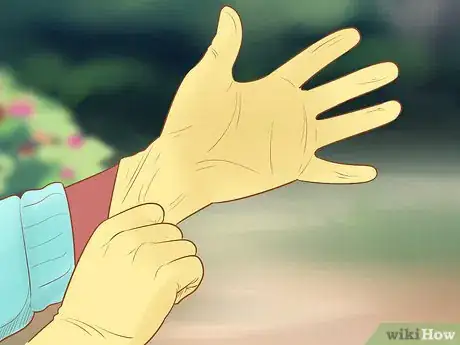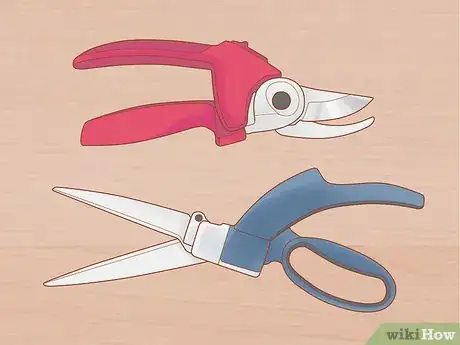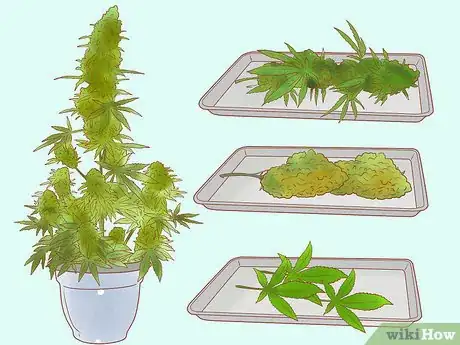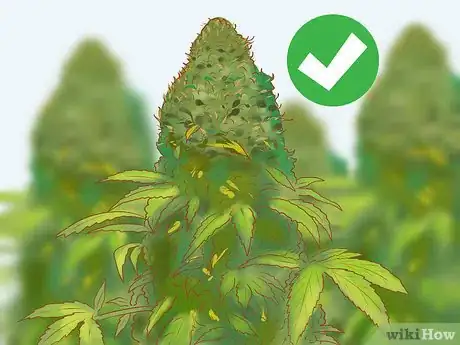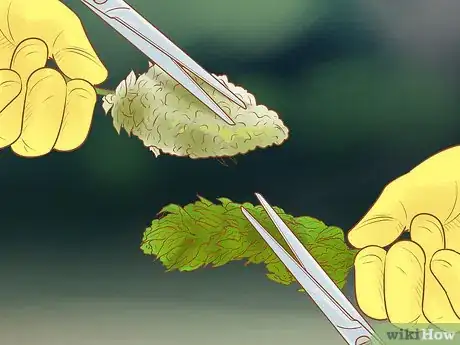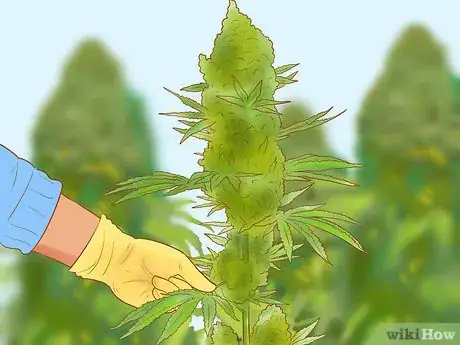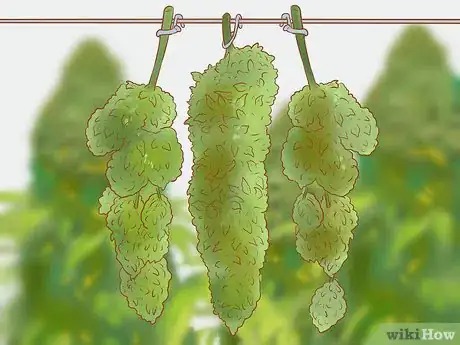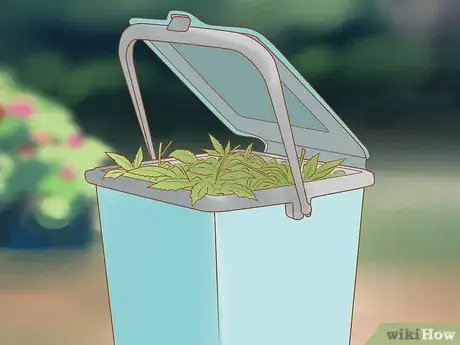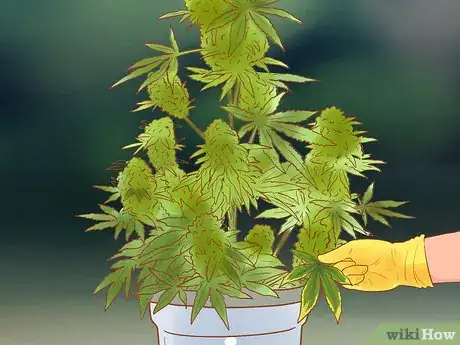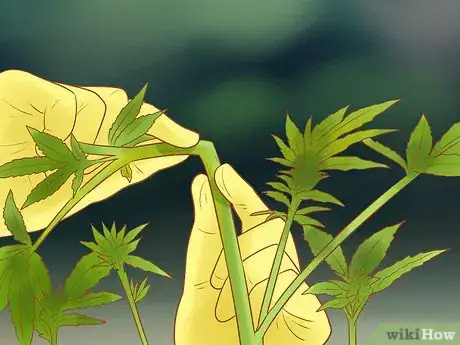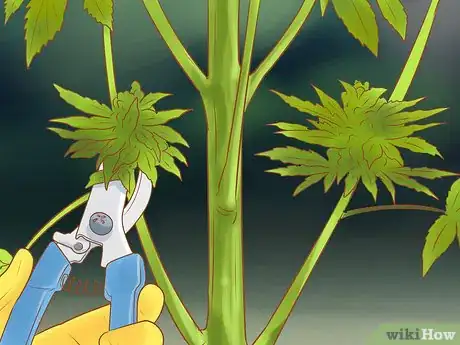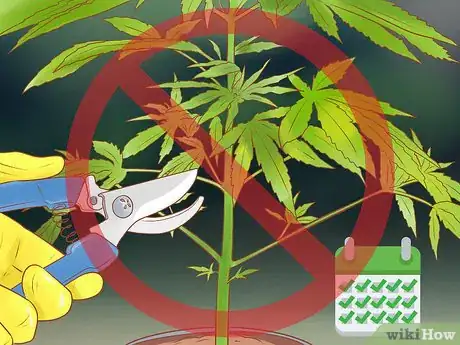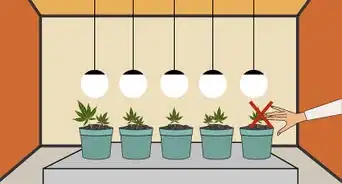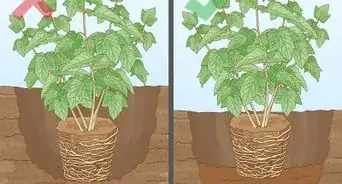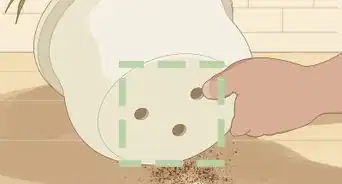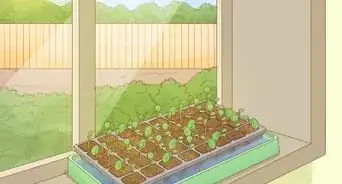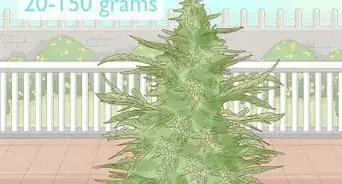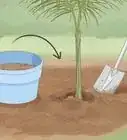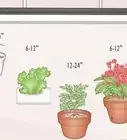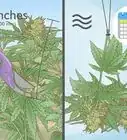This article was co-authored by Lauren Kurtz. Lauren Kurtz is a Naturalist and Horticultural Specialist. Lauren has worked for Aurora, Colorado managing the Water-Wise Garden at Aurora Municipal Center for the Water Conservation Department. She earned a BA in Environmental and Sustainability Studies from Western Michigan University in 2014.
There are 13 references cited in this article, which can be found at the bottom of the page.
wikiHow marks an article as reader-approved once it receives enough positive feedback. In this case, 93% of readers who voted found the article helpful, earning it our reader-approved status.
This article has been viewed 868,731 times.
Trimming cannabis plants is something of an art. With all the right cuts, you’ll have a compact, high-yield crop, with extra trimmings left over for things like hash, extracts, or oils. Before you pick up those scissors and get to chopping, though, there are a few things you ought to know to get the most out of your Mary Jane. We’ll fill you in on the tools you need, how to trim when the time comes, and maintenance tips from gardening experts to help you grow the good stuff.
Things You Should Know
- Wear gloves, and use clean garden trimming shears or scissors.
- Trim once the resin on the tips of the buds turns cloudy white or amber. If space is limited, trim the plant before hanging it to dry (wet trimming).
- Clip away the large, 5-pointed fan leaves. Also clip any smaller sugar leaves that don’t hold any resin.
- Hang your buds from strings in a well-ventilated area for 1-3 months, or until they’re springy to the touch.
Steps
Setting up Your Workspace
-
1Put on gloves to protect your hands from sticky resin. The marijuana plant’s resin can be difficult to wash off, and handling it in large quantities without protection might contribute to developing allergies.[1] Slip on disposable rubber gloves to protect your hands from sticky buds.
-
2Clean your trimming shears and scissors. Use trimming shears or scissors to cut away branches without straining the muscles in your hands.[2] Disinfect your tools with isopropyl alcohol wipes to keep them ready to snip and avoid spreading pathogens between plants.[3] Marijuana plants are fragile and can be sensitive to rough treatment. Take your time, and trim carefully.
- Your fingers are your third tool in your trimming arsenal—you’ll pluck away the plants’ tips with your gloved fingers.
- Some growers use machine trimming solutions, but specialized trimming machines are pricey and not typically practical for small-scale growers.
Advertisement -
3Arrange a few metal trays to separate your trimmings. As you trim, don’t simply discard the leaves and other cuttings—these can be used to make edibles or hashish. Set out a few cookie sheets or other wide containers near the plants you’ll be trimming. Use 1 to catch trimmed buds, and others to collect discarded plant matter.[4]
-
4Trim your crop when the resin is cloudy or amber-colored. Wait to harvest until your marijuana plant has a cluster of cloudy white or reddish-brown hairs sticking out the top. These are the plant’s trichomes, which produce the THC-laden resin. As the plant ages, the resin on these trichomes changes from clear white to cloudy or amber (depending on the strain), which means your crop is ready to harvest.[5]
- Note that the top of the plant tends to mature faster than the bottom, so you may need to harvest different areas of the plant at different times.
-
5Perform a wet trim if your space is limited. There are 2 common methods of trimming: “wet” and “dry.” With a wet trim, you trim the plant right after harvesting, while it’s still hydrated. A wet trim makes it easier to prune leaves, speeds the drying process, and prevents mold from forming on your crop. It’s great for growers in a humid environment or with limited space that can’t fit industrial drying racks.[6]
- A “dry” trim, on the other hand, is performed after the plant has been hung and dehydrated.
- A dry trim preserves the bud’s shape and is generally less sticky. Because the plant is dry, though, you need to be extra careful not to crinkle off any trichomes.
Harvesting Buds
-
1Clip the fan leaves. The fan leaves are the large leaves with 5 distinct points—a large, long point in the center and two smaller points on either side. Pluck fan leaves with your fingers, scissors, or shears.[7]
- Some people choose to clip their fan leaves later, after they’ve cured the plant. This slows down the drying process and produces more flavorful buds.
-
2Trim the sugar leaves. The sugar leaves are those that emerge from the buds themselves. They are so short that their stems often cannot be seen. Use your scissors to carefully reach into the bud and snip them off at the stem. If you like, leave any sugar leaves that have a healthy amount of trichomes, which can contribute to the overall THC yield.[8]
- Trimming all the sugar leaves often makes for a smoother and more potent crop.[9]
-
3Leave the buds on the stem so you can hang them. Generally, it’s a good idea to leave the buds on the stem. This slows the drying process and allows you to hang the buds to dry, as opposed to using specialized drying racks.[10] If you’re in a high-humidity environment, remove the buds in order to advance the drying process.
-
4Hang the branches to cure. When the bud-bearing branches have been removed and partitioned into individual pieces, it’s time to dry and cure them. Using string or twist ties, hang the branches on your laundry line in a well-ventilated area so that all parts are exposed to air. Hang your plants in a room with a temperature of about 60–70 °F (16–21 °C) for 1-3 months.[11] Keep a fan or window open in the room to improve ventilation.
- Use a humidity meter to ensure the humidity level of the room never drops below 50%.
- Don't expose your harvested plants to direct sunlight, heat, or moisture. The latter is especially bad, as it can produce mold, which can ruin a crop.
- Your crop is done curing once the buds are springy when you touch them, and the stems snap easily rather than bend.
-
5Pluck the dried buds from the stems. Once dry and ready, use your fingers to carefully pinch the buds away from the greater stems. Then, clip the rest of the leaves from all of the branches. Store these in airtight containers.[12] Once a marijuana plant has been totally trimmed of its buds and leaves, place it in your compost bin or put it out with the rubbish.
Marijuana Plant Maintenance
-
1Remove dead fan leaves leading up to harvest time. As harvest time approaches, reach into the branches of the live plant and remove all of the dead and dying fan leaves (identifiable by their yellow hue) from the branches. This process allows the plant to focus as much energy as possible on growing healthy leaves, rather than wasting energy maintaining leaves that may die anyway. A gentle tug, sometimes firm, is all that's required to remove most dead leaves.[13]
- Trimming away dying plant leaves also lets more sunlight through to the lower parts of the plant, helping you grow better marijuana.
-
2Cut all branches and shoots that are not directly connected to the trunk. As branches grow out from the main stalk of the plant, they in turn develop shoots and branches of their own. However, they will struggle to get enough light and sap energy from the leaves located at the ends of the main branches. Trim these leaves and shoots away at the base with heavier pruning shears for a clean cut.[14]
-
3“FIM” or top your plant. FIMing refers to the process of cutting the topmost vegetation (known as a "top") from your plant in order to double the number of buds it produces, and causing the plant to grow out instead of up. "Topping" means to remove the whole topmost shoot down to the base. Both techniques encourage greater bud growth, making the most of limited growing space.[15]
- To FIM your marijuana plant, locate a new shoot, then use your shears or other trimming instrument to snip 2/3 of the shoot’s length.
- The term “FIM” comes from the phrase, “F***, I missed,” often said when a grower makes a mistake while topping, which is where the practice originated.
-
4Super crop your plant to encourage stronger branch growth. Select a mature green branch. With both hands, gently bend the branch back and forth until you hear the branch crack and see a bit of white discoloration. Finally, rest the bent branch on top of or against a nearby branch to support its weight.[16]
- Super cropping causes the plant to heal and rebuild a stronger branch, allowing for more efficient circulation of nutrients and water within the plant.
-
5Pluck low-lying buds. If you see small buds sprouting from the lower portion of your plant, pluck or clip them off. These small buds will only drain energy from the larger and more plentiful buds growing near the top of the plant.[17]
-
6Trim your marijuana plant about twice a month. After trimming your plant, it needs time to recover and heal. Your plant will often only need to be trimmed twice a month. Prune more often, every 3-4 days, during your plant’s early vegetative stage (when it first produces leaves) and toward the end of its flowering (bud-producing) stage.[18]
Expert Q&A
Did you know you can get premium answers for this article?
Unlock premium answers by supporting wikiHow
-
QuestionIf my tree was an outdoor tree, can I change it to indoor during the final aging process, and how will that affect my tree?
 Lauren KurtzLauren Kurtz is a Naturalist and Horticultural Specialist. Lauren has worked for Aurora, Colorado managing the Water-Wise Garden at Aurora Municipal Center for the Water Conservation Department. She earned a BA in Environmental and Sustainability Studies from Western Michigan University in 2014.
Lauren KurtzLauren Kurtz is a Naturalist and Horticultural Specialist. Lauren has worked for Aurora, Colorado managing the Water-Wise Garden at Aurora Municipal Center for the Water Conservation Department. She earned a BA in Environmental and Sustainability Studies from Western Michigan University in 2014.
Professional Gardener
-
QuestionDoes the color of the bud change during the drying process?
 Lauren KurtzLauren Kurtz is a Naturalist and Horticultural Specialist. Lauren has worked for Aurora, Colorado managing the Water-Wise Garden at Aurora Municipal Center for the Water Conservation Department. She earned a BA in Environmental and Sustainability Studies from Western Michigan University in 2014.
Lauren KurtzLauren Kurtz is a Naturalist and Horticultural Specialist. Lauren has worked for Aurora, Colorado managing the Water-Wise Garden at Aurora Municipal Center for the Water Conservation Department. She earned a BA in Environmental and Sustainability Studies from Western Michigan University in 2014.
Professional Gardener
-
QuestionCan I trim the buds off the plant and keep the plant alive so it can rebud again?
 wikiHow Staff EditorThis answer was written by one of our trained team of researchers who validated it for accuracy and comprehensiveness.
wikiHow Staff EditorThis answer was written by one of our trained team of researchers who validated it for accuracy and comprehensiveness.
Staff Answer wikiHow Staff EditorStaff Answer
wikiHow Staff EditorStaff Answer
Warnings
- Always research the legality of marijuana cultivation in your area before you begin.⧼thumbs_response⧽
References
- ↑ https://www.cdc.gov/mmwr/volumes/67/wr/mm6708a7.htm
- ↑ https://mjbizdaily.com/honing-trimming-skills/
- ↑ https://ipm.missouri.edu/MEG/2018/1/cleaning_pruning_tools/
- ↑ https://hemptemps.com/news/trimming-101-the-basics-of-cannabis-trimming-positions/
- ↑ https://cannabis.ny.gov/system/files/documents/2022/10/medical-home-cultivation-guide-.pdf
- ↑ https://www.cannaconnection.com/blog/18188-how-to-trim-and-clean-buds-after-harvest
- ↑ https://www.greenhousegrower.com/production/how-to-pinch-and-prune-your-way-to-a-successful-crop/
- ↑ https://mjbizdaily.com/honing-trimming-skills/
- ↑ https://www.cannaconnection.com/blog/18188-how-to-trim-and-clean-buds-after-harvest
- ↑ https://www.cannaconnection.com/blog/18188-how-to-trim-and-clean-buds-after-harvest
- ↑ https://cannabis.ny.gov/system/files/documents/2022/10/medical-home-cultivation-guide-.pdf
- ↑ https://cannabis.ny.gov/system/files/documents/2022/10/medical-home-cultivation-guide-.pdf
- ↑ https://potguide.com/blog/article/how-to-trim-your-cannabis/#how-fast-can-you-trim-cannabis
- ↑ https://www.greenhousegrower.com/production/how-to-pinch-and-prune-your-way-to-a-successful-crop/
- ↑ https://howtogrowmarijuana.com/fimming/
- ↑ https://www.maximumyield.com/definition/4691/super-cropping-cannabis
- ↑ https://potguide.com/blog/article/how-to-trim-your-cannabis/#how-fast-can-you-trim-cannabis
- ↑ https://www.greenhousegrower.com/production/how-to-pinch-and-prune-your-way-to-a-successful-crop/
About This Article
To trim a marijuana plant, wait until the majority of the plant’s pistils, which look like a cluster of white hairs sticking out of the top, turn to a reddish-brown. In order to harvest the buds, clip the fan leaves, which are the large leaves that have 5 distinct points. In addition to the fan leaves, trim the sugar leaves, which are the ones that emerge from the actual buds. Once you remove the bud-bearing branches, use a string or twist ties to hang them on a laundry line to dry. After the buds are dry, remove them from the hanging branches, clip the rest of the leaves, and compost the remainder of the plant. To learn how to best maintain your marijuana plant, keep reading!
